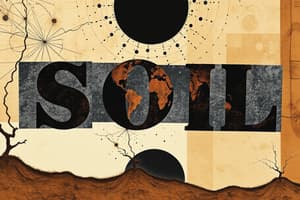Podcast
Questions and Answers
Which horizon is primarily composed of organic matter and overlying the A horizon?
Which horizon is primarily composed of organic matter and overlying the A horizon?
- O horizon (correct)
- A horizon
- B horizon
- C horizon
What is the role of biological organisms in soil formation?
What is the role of biological organisms in soil formation?
- Enhancing soil temperature stability
- Contributing to the breakdown of organic matter (correct)
- Controlling soil pH levels
- Increasing soil erosion rates
Which factor is NOT mentioned as influential in soil formation?
Which factor is NOT mentioned as influential in soil formation?
- Temperature
- Humidity
- Sunlight exposure (correct)
- Precipitation
Which horizon typically reflects secondary processes in soil development?
Which horizon typically reflects secondary processes in soil development?
What influence does time have on soil formation?
What influence does time have on soil formation?
What is the primary function of the solum in the Earth's crust?
What is the primary function of the solum in the Earth's crust?
Which of the following best describes the relationship between the solum and the underlying parent material?
Which of the following best describes the relationship between the solum and the underlying parent material?
Which factor does NOT influence the depth of the solum?
Which factor does NOT influence the depth of the solum?
What role does organic matter play in the characteristics of the solum?
What role does organic matter play in the characteristics of the solum?
Which of the following components is NOT typically found in the solum?
Which of the following components is NOT typically found in the solum?
How does air space within the solum benefit plant life?
How does air space within the solum benefit plant life?
What are considered the five factors of soil formation?
What are considered the five factors of soil formation?
What effect does the ratio of sand, silt, and clay have on soil?
What effect does the ratio of sand, silt, and clay have on soil?
Flashcards
Climate's Influence on Soil
Climate's Influence on Soil
Factors like temperature, rainfall, and moisture levels that influence soil formation.
Biological Activity in Soil Formation
Biological Activity in Soil Formation
Living organisms, like worms and bacteria, break down organic matter, mix the soil, and cycle nutrients.
Topography's Role in Soil Formation
Topography's Role in Soil Formation
Slope and elevation affect drainage and erosion, leading to different soil types on hillsides vs. flat areas.
Time and Soil Development
Time and Soil Development
Signup and view all the flashcards
Soil Horizons
Soil Horizons
Signup and view all the flashcards
What is soil (solum)?
What is soil (solum)?
Signup and view all the flashcards
What is parent material in soil formation?
What is parent material in soil formation?
Signup and view all the flashcards
What are soil horizons?
What are soil horizons?
Signup and view all the flashcards
What is weathering in soil formation?
What is weathering in soil formation?
Signup and view all the flashcards
What is decomposition in soil formation?
What is decomposition in soil formation?
Signup and view all the flashcards
What is soil texture?
What is soil texture?
Signup and view all the flashcards
What is soil structure?
What is soil structure?
Signup and view all the flashcards
What is organic matter in soil?
What is organic matter in soil?
Signup and view all the flashcards
Study Notes
Soil Defined as Solum
- Soil, often referred to as 'solum', is the uppermost layer of Earth's crust supporting plant life. It's a complex mix of minerals, organic matter, water, air, and living organisms.
- The solum differs from the underlying parent material, the geological source of the soil's development.
- The solum has distinct horizons (layers) with varying properties (color, texture, structure, composition).
- Solum depth varies with factors like climate, topography, and landform age. Depth is also a function of soil-forming processes.
- The solum is a dynamic, evolving system driven by rock weathering, organic matter decomposition, and soil organism activity. These processes shape its properties and structure.
Key Features of the Solum
- The solum's components include mineral particles (sand, silt, clay), organic matter (humus), water, and air—all in dynamic interaction.
- Mineral particle composition affects soil texture, structure, and water-holding capacity.
- Sand, silt, and clay ratios dictate soil workability and drainage.
- Organic matter levels correlate with soil fertility and plant support.
- Water is essential for nutrient transport and plant growth within the solum.
- Air spaces for soil organism respiration and plant root oxygen are crucial, linked to soil drainage.
Soil Forming Factors
- Soil formation involves five key factors: parent material, climate, organisms (biotic and abiotic), topography, and time.
- Parent material determines the soil's mineral composition.
- Climate influences weathering, chemical reactions (temperature, precipitation, humidity).
- Biotic organisms (insects, earthworms, microorganisms) break down organic matter, mix soil, and cycle nutrients.
- Topography (slope, elevation) affects soil drainage and erosion, impacting soil differences between slopes and flat areas.
- Time is essential. It influences weathering extent and horizon development; longer time leads to more developed soil profiles.
Soil Horizons
- Soil horizons are distinct layers within the solum, reflecting variations in soil characteristics (composition, structure).
- The A horizon (uppermost) has high organic matter and is biologically active.
- The B horizon (deeper) often accumulates minerals or clays, showing secondary processes.
- The C horizon transitions into the parent material.
- The O horizon (above the A) is mostly organic matter, showing organic matter accumulation levels.
- The arrangement of these horizons indicates the soil-forming process and environment.
Studying That Suits You
Use AI to generate personalized quizzes and flashcards to suit your learning preferences.




